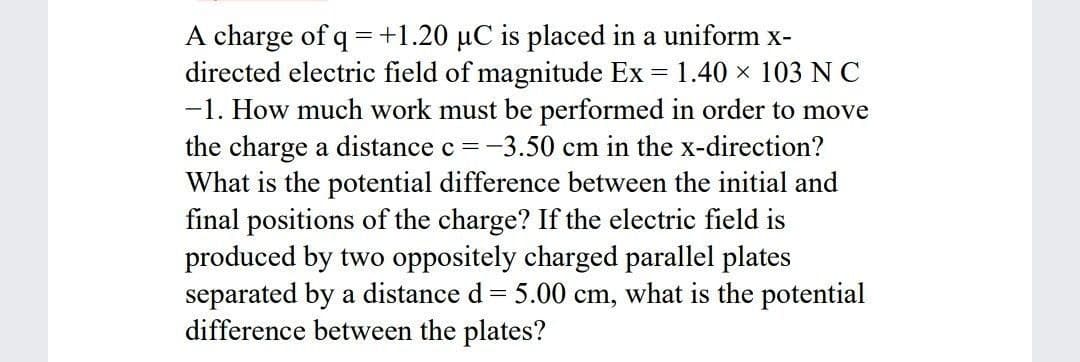A charge of q =+1.20 µC is placed in a uniform x- directed electric field of magnitude Ex = 1.40 x 103 N C -1. How much work must be performed in order to move the charge a distance c = -3.50 cm in the x-direction? What is the potential difference between the initial and final positions of the charge? If the electric field is produced by two oppositely charged parallel plates separated by a distance d= 5.00 cm, what is the potential difference between the plates? %3D
A charge of q =+1.20 µC is placed in a uniform x- directed electric field of magnitude Ex = 1.40 x 103 N C -1. How much work must be performed in order to move the charge a distance c = -3.50 cm in the x-direction? What is the potential difference between the initial and final positions of the charge? If the electric field is produced by two oppositely charged parallel plates separated by a distance d= 5.00 cm, what is the potential difference between the plates? %3D
Principles of Physics: A Calculus-Based Text
5th Edition
ISBN:9781133104261
Author:Raymond A. Serway, John W. Jewett
Publisher:Raymond A. Serway, John W. Jewett
Chapter20: Electric Potential And Capacitance
Section: Chapter Questions
Problem 37P
Related questions
Concept explainers
Dielectric Constant Of Water
Water constitutes about 70% of earth. Some important distinguishing properties of water are high molar concentration, small dissociation constant and high dielectric constant.
Electrostatic Potential and Capacitance
An electrostatic force is a force caused by stationary electric charges /fields. The electrostatic force is caused by the transfer of electrons in conducting materials. Coulomb’s law determines the amount of force between two stationary, charged particles. The electric force is the force which acts between two stationary charges. It is also called Coulomb force.
Question
A charge of q =+1.20 pC is placed in a uniform x- directed electric field of magnitude Ex = 1.40 x 103 N C —1. How much work must be performed in order to move the charge a distance ¢ =—3.50 cm in the x-direction? What is the potential difference between the initial and final positions of the charge? If the electric field is produced by two oppositely charged parallel plates separated by a distance d = 5.00 cm, what is the potential difference between the plates?

Transcribed Image Text:A charge of q =+1.20 µC is placed in a uniform x-
directed electric field of magnitude Ex = 1.40 x 103 NC
-1. How much work must be performed in order to move
the charge a distance c =-3.50 cm in the x-direction?
What is the potential difference between the initial and
final positions of the charge? If the electric field is
produced by two oppositely charged parallel plates
separated by a distance d= 5.00 cm, what is the potential
difference between the plates?
Expert Solution
This question has been solved!
Explore an expertly crafted, step-by-step solution for a thorough understanding of key concepts.
Step by step
Solved in 2 steps with 2 images

Knowledge Booster
Learn more about
Need a deep-dive on the concept behind this application? Look no further. Learn more about this topic, physics and related others by exploring similar questions and additional content below.Recommended textbooks for you

Principles of Physics: A Calculus-Based Text
Physics
ISBN:
9781133104261
Author:
Raymond A. Serway, John W. Jewett
Publisher:
Cengage Learning

College Physics
Physics
ISBN:
9781285737027
Author:
Raymond A. Serway, Chris Vuille
Publisher:
Cengage Learning


Principles of Physics: A Calculus-Based Text
Physics
ISBN:
9781133104261
Author:
Raymond A. Serway, John W. Jewett
Publisher:
Cengage Learning

College Physics
Physics
ISBN:
9781285737027
Author:
Raymond A. Serway, Chris Vuille
Publisher:
Cengage Learning


College Physics
Physics
ISBN:
9781305952300
Author:
Raymond A. Serway, Chris Vuille
Publisher:
Cengage Learning

Physics for Scientists and Engineers: Foundations…
Physics
ISBN:
9781133939146
Author:
Katz, Debora M.
Publisher:
Cengage Learning

Physics for Scientists and Engineers, Technology …
Physics
ISBN:
9781305116399
Author:
Raymond A. Serway, John W. Jewett
Publisher:
Cengage Learning